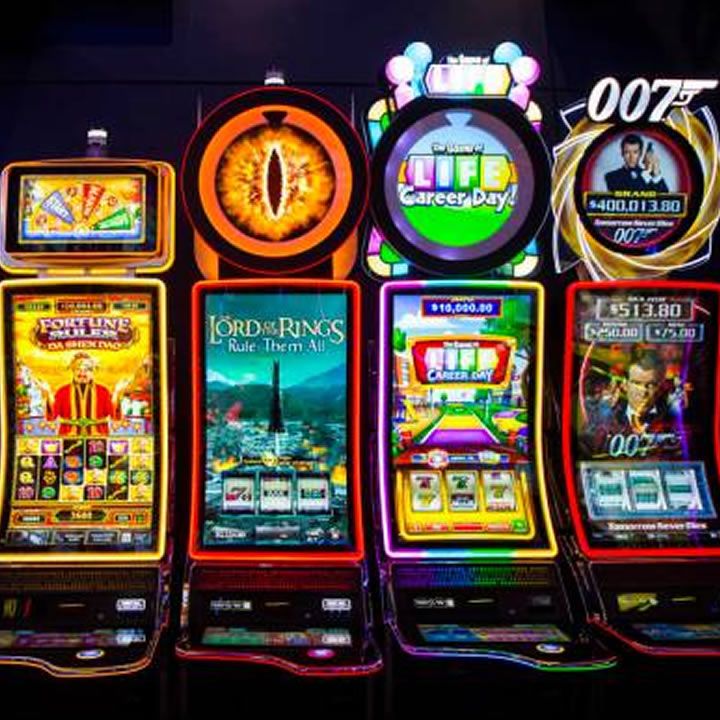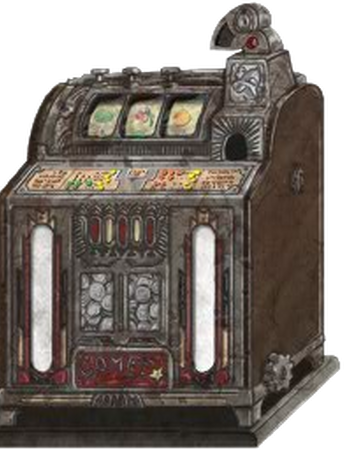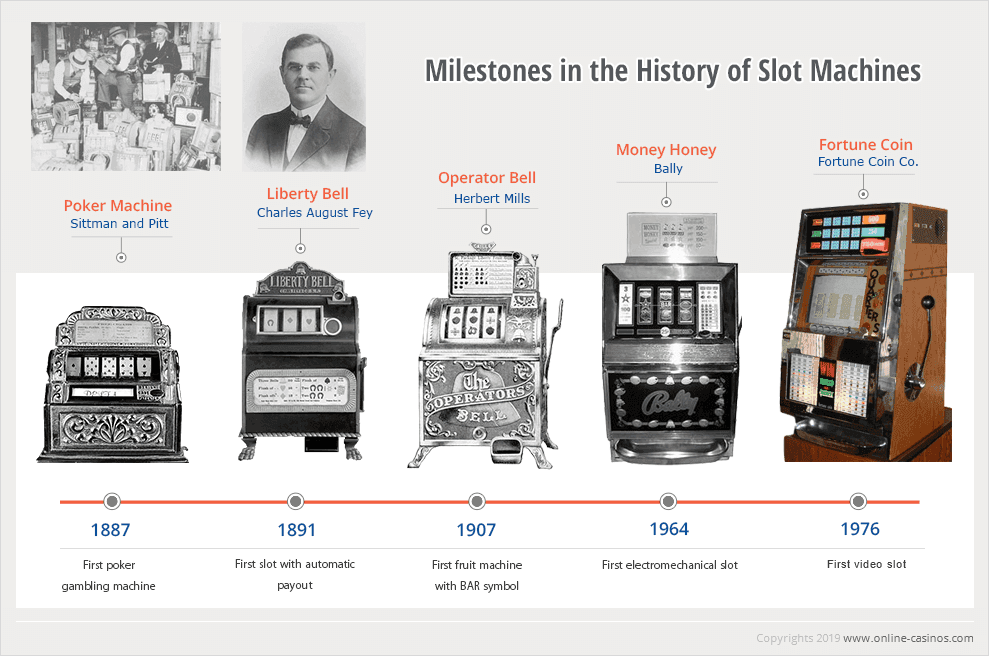1975: First Video Slot Machine Hits Casino Floors Walt Fraley invents the 'Fortune Coin' video screen game. At the time it was not popular as players where skeptical about the technology and did not trust the virtual reels over the wide spread spinning reel slots.
- Created The First Slot Machine In 1895 Penny
- Created The First Slot Machine In 1895 Value
- Created The First Slot Machine In 1895 United States
- Created The First Slot Machine In 1895 Indian Head
- In 1894, on the other side of the United States, a San Francisco-based inventor named Charles August Fey invented the first version of what we’d recognize as a classic slot machine. Shortly after this, he built the 4-11-44, which was so successful that he quit his job to build them full time.
- The history of the slot symbol began when a mechanic named Charles Fey invented the first-ever slot machine back in 1895. This early effort had three spinning reels that contained 5 symbols that included horseshoes, diamonds, spades, hearts and a Liberty Bell.
Continuing on with the riveting consumer-life lecture series, which covers topics such as “Self Checkout: Burden or Blessing?” and “Customer Service Confrontations Through the Ages,” today’s discussion takes a look back at the history of a marketing ploy that seems to give customers something for nothing.

Apparently, coupons haven’t been around quite as long as the oldest profession (buy two, get one free?). Coca-Cola was the first product to get customers hooked via coupons, starting in 1887, as Coupon Sherpa tells it:
Atlanta businessman Asa Candler had a brainstorm in 1887 when he created the first coupon. At the time, brainstorm referred to a brief period of insanity, but you can’t question the Coca-Cola co-owner’s sanity when he hit upon this invaluable marketing device.
Candler’s invention transformed Coca-Cola from an insignificant tonic into a market-dominating drink. His hand-written tickets offered consumers a free glass of Coca-Cola, then priced at five cents. Between 1894 and 1913, an estimated one-in-nine Americans had received a free Coca-Cola, for a total of 8,500,000 free drinks. By 1895, Coca-Cola was being served in every state.
In the early 1900s, discounts were available on cereals thanks to coupons, and then coupon usage really took off in the Great Depression, as Coupon Sherpa’s timeline (which, unsurprisingly, is heavy on the importance of mobile coupons—Coupon Sherpa’s business model) shows:
You might have assumed that recession-dampened 2009 was a boom year for coupons. And it was, sort of: Something like 3.5 billion coupons were redeemed last year, 700,000 more than in 2008. But overall, old-fashioned physical coupons have been in decline since the early ’90s; the high point was 1992, when 7.9 billion discounts were granted via coupons.
Fascinating, I know. Up next in the lecture series: “Take a Number: Deli Meat & You.”
The year was 1892. In a very small village in Clayton county of Northeast Iowa, the very first tractor was created by John Froelich. It had yet to be named the tractor, but it was the first successful gasoline engine that could maneuver forwards and backwards; the most rudimentary functions of modern engines.
Prior to widespread tractor use, farmers relied on steam-powered engines and back-breaking work to thresh wheat. The engines were bulky and very heavy, making them difficult to maneuver, and they frequently set fire to the stubble and grain in the fields. Froelich took a crew of men out to Langford, South Dakota every fall to work on the fields, so he was very familiar with steam engines and their many issues. He was determined to invent a better way to power the engines.
The answer was gasoline. Froelich worked with blacksmith Will Mann to come up with a vertical, one-cylinder engine mounted onto the running gear of the steam engine. After a few weeks of testing, it was time to take his crew back out to the South Dakota fields, where he would try out his new creation in the fields. That fall, Froelich’s crew threshed 72,000 bushels of small grain, making the new equipment a complete success.
Later that fall, Froelich transported his new invention to Waterloo, Iowa to present to a group of businessmen. The men were so impressed they immediately formed a company to manufacture and produce these engines. The company was named the Waterloo Gasoline Traction Engine Company and Froelich was made president. The new machine was called the “Froelich tractor” after its inventor.
Unfortunately, attempts to sell the tractors were unsuccessful, despite how practical they were. Only two were sold, and both were returned shortly after being sold. The company had to settle with manufacturing stationary gas engines to generate income while new experiments were conducted with the Froelich tractor.

In 1895, the Waterloo Gasoline Engine Company incorporated. Froelich decided to withdraw himself from the company, however, because his interest was in tractors, and not stationary engines.
After years of trying to improve the tractor while building standard engines, the Waterloo company made the “L-A” model in 1913. Then, in 1914, they introduced the first Waterloo Boy Tractor, the single speed “R” model. Farmers liked this model, and they sold 118 of them within the first year. Shortly after, the “N” model was released, which had two forward speeds. This model was also successful.
Created The First Slot Machine In 1895 Penny

Farm prices and demand for dependable mechanical farm power began to rise during World War I, making the tractor an incredibly popular concept. Within months, multiple tractor manufacturers began to pop up. Deere and Company in Moline, Illinois, a manufacturer of John Deere equipment, had been keeping a close eye on the progress, improving quality of products, and success of the Waterloo Company. John Deere was searching for an established tractor to complete its line of farm equipment. They decided that the Waterloo Company knew what farmers wanted and how to build a quality tractor.
March 14, 2018, marked the 100th anniversary of the day Deere & Company purchased the Waterloo Gasoline Engine Company, in Waterloo, Iowa.
Created The First Slot Machine In 1895 Value
Over the intervening century of experiment and trial, John Froelich’s humble invention has improved greatly, and today, the John Deere Waterloo Works is still one of the largest tractor producing plants in the nation. Every day, descendants of the original Waterloo Boy, tractors of all sizes and types, are sold to farmers all over the world. These tractors make farming easier and more profitable.
Created The First Slot Machine In 1895 United States
If you visit the John Deere Tractor & Engine Museum in Waterloo, you can see more than 100 years of history on display, including an original Waterloo Boy.
The small 1890s village is now known as Froelich, Iowa and boasts the name of “Tractor Town, U.S.A.”, in honor of the tractor’s creator. There is a museum where you can find a scale model of the original Froelich Tractor, that was built based off of the authentic blueprints, which you can find on display. They also hold an annual celebration the last weekend of September, called “Fall-der-all”, where tractors from the very first Froelich to the newest John Deere, are displayed.